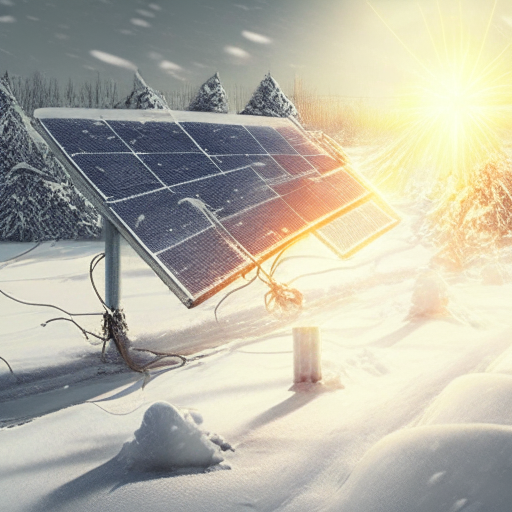Maximize Your Solar Energy Efficiency Even in Harsh Winter Conditions
As a dedicated survivalist, your journey towards self-sufficiency becomes even more critical when faced with the daunting challenges of winter weather. One of the foremost concerns in such conditions is the effective utilization of renewable energy sources, particularly solar energy, amid the biting cold. While frigid temperatures might seem like a significant barrier, there is no need for alarm! This article will reveal the untapped potential of solar power in cold climates. We will share actionable strategies that empower you to harness solar energy effectively, even in the severest winter conditions, by adopting a proactive and well-informed approach to your energy needs.

A common misconception is that solar electricity is only feasible in warm, sun-soaked regions. However, with substantial advancements in technology, capturing solar energy in colder climates has become entirely feasible. Let’s explore various techniques that empower solar power systems to thrive even in extreme cold, and discover how you can effectively leverage this sustainable, eco-friendly energy source to enhance your lifestyle and survival strategies for a more resilient future.
Understanding the fundamentals of solar power is crucial. Solar panels generate energy from sunlight, not warmth. Although cooler temperatures can influence the efficiency of solar panels, they do not render them ineffective during the winter months. By implementing strategic planning and innovative techniques, you can significantly boost your solar power system’s performance, ensuring optimal operation even in the coldest environments. Gaining insight into how solar panels function across various temperatures will enable you to make informed decisions that meet your energy demands effectively.
One vital factor in optimizing solar electricity in cold climates is the angle and orientation of your solar panels. Correct alignment can dramatically increase the amount of sunlight your panels absorb throughout the day. In winter, the sun’s path dips lower in the sky, making it essential to tilt your panels at a steeper angle. This adjustment facilitates maximum sunlight capture, thus enhancing their efficiency. Additionally, orienting your panels toward the south can further improve their sunlight collection capabilities, which is particularly advantageous during the shorter winter days when every bit of light counts.
Snow accumulation poses another significant challenge in colder regions that can obstruct the effectiveness of your solar panels. A thick layer of snow can drastically reduce electricity output. However, by proactively addressing this issue, you can discover effective solutions. Consider installing snow barriers or heating elements on your solar panels to prevent snow buildup. These enhancements not only help melt existing snow but also ensure continuous energy production, even during snowstorms. Regularly clearing snow by hand can also be an effective maintenance strategy to keep your panels functioning optimally and free from obstructions.
Incorporating battery storage systems represents a forward-thinking strategy to increase solar power efficiency in cold conditions. These batteries store surplus energy generated during daylight hours for use when sunlight is limited or temperatures drop. The importance of battery storage becomes especially evident in freezing conditions, as it guarantees a reliable supply of electricity when you need it most. By investing in a dependable battery system, you can maintain your energy independence and be well-prepared for any unforeseen circumstances that may arise during severe winter weather.
Choosing the right type of solar panels is critical for optimizing your solar energy system’s efficiency in cold climates. Certain panels are specifically engineered to perform better at lower temperatures and may feature enhanced insulation or specialized materials designed to minimize the impact of frost and ice on their performance. By making an informed choice about the panel types that best suit your cold environment, you can maximize energy production and ensure that your solar power system effectively meets your energy needs, even in challenging conditions.
Beyond technical considerations, having your solar power system installed by professionals experienced in cold climate conditions is essential. Skilled installers can provide best practices for installation, ongoing maintenance, and troubleshooting, offering invaluable insights into optimizing your system. Their expertise not only ensures that your solar setup operates at peak efficiency but also enhances the reliability of your energy source, even under the most challenging winter conditions.
Maintaining a proactive and prepared mindset is crucial in survival scenarios. While solar power can serve as a dependable and effective energy source in cold climates, having backup generators or alternative energy solutions is vital. These additional measures will act as a safety net in case of extended periods of low sunlight or unexpected system failures. By integrating solar power with other renewable energy sources, you can further enhance your energy independence and resilience, ensuring that you are well-equipped to tackle any weather-related challenges that may arise.
Solar energy is not confined to warm and sunny regions; it holds immense potential even in the coldest climates, provided it is strategically planned and technically advanced. By adjusting your panel angles, mitigating snow accumulation, incorporating battery storage, selecting suitable solar panels, relying on skilled installation, and having contingency plans, you can unlock the complete potential of solar energy in extreme cold. Embrace renewable energy with confidence and resourcefulness, securing your survival and sustainability in any climate.
The post Solar Energy in Extreme Cold: Unlocking Its Full Potential appeared first on Survival Bite.
The Article Solar Energy’s Full Potential in Extreme Cold Conditions Was Found On https://limitsofstrategy.com


This is an intriguing topic that touches on the intersection of sustainability, technology, and the unique challenges presented by harsh climates. As someone who has lived in both temperate and colder regions, I can attest to the common belief that solar energy is not viable during winter months. However, experiencing snow-covered landscapes while harnessing solar power has truly changed my perspective.
It’s really refreshing to hear your perspective, especially after living in both temperate and colder regions. Many people carry that assumption that solar energy just takes a break during winter months, and the first snowfall often brings a wave of hesitation about solar panels. Your experience highlights an essential aspect of solar technology: it’s more versatile than many realize.
It’s interesting to hear about your personal experience with solar power in snowy environments. Many people do assume that winter conditions render solar energy useless, but it’s great to see how your perspective has shifted.
You bring up a great point about the perceptions surrounding solar energy in colder regions. It’s fascinating how our understanding can shift when we actually see the technology in action. Like you, I’ve always thought of solar panels as something best suited for sunny climates. But I’ve read about solar installations in places like Scandinavia where the technology thrives even in those snowy months.
It’s fascinating to think about how solar energy can be harnessed effectively even in the depths of winter. I’ve been experimenting with solar panels for a few years now, and I’ve realized that the angle of sunlight and the reflection from snow can significantly enhance energy capture in colder months. It’s encouraging that technology has advanced to make this more viable.